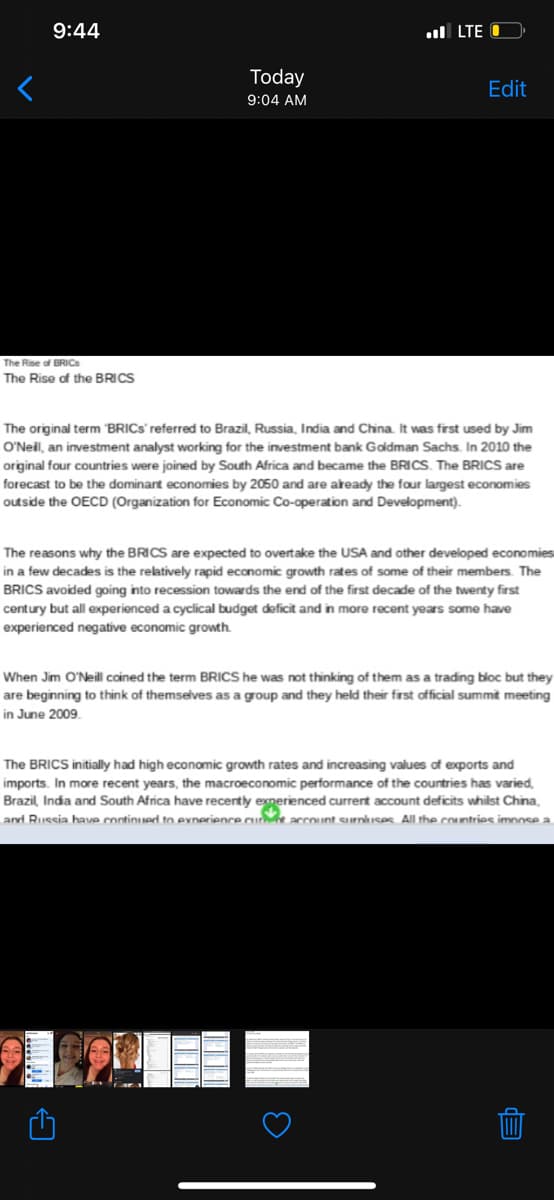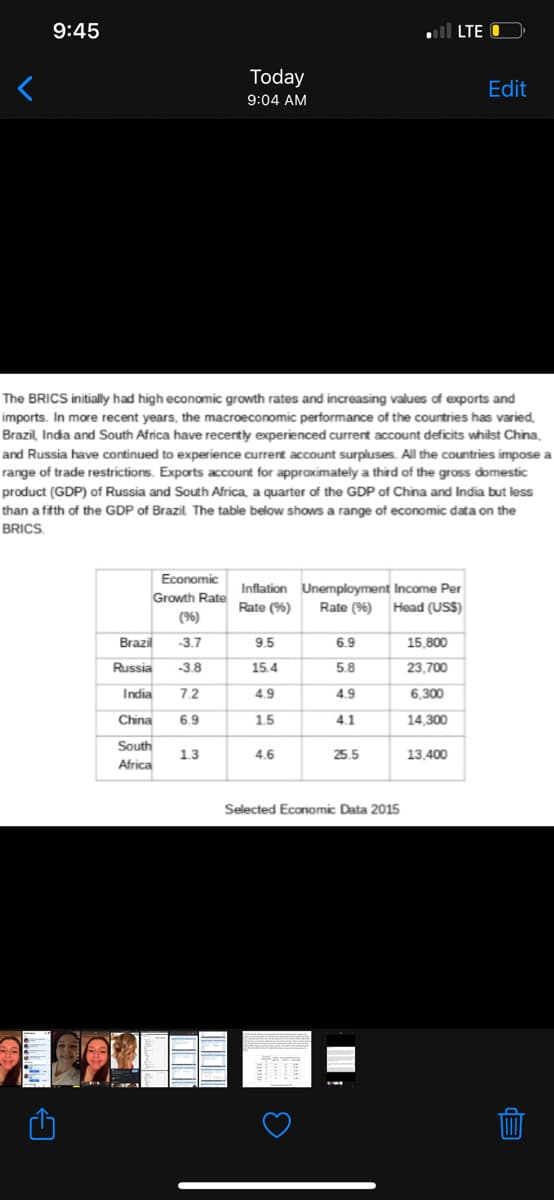Principles of Economics 2e
2nd Edition
ISBN:9781947172364
Author:Steven A. Greenlaw; David Shapiro
Publisher:Steven A. Greenlaw; David Shapiro
Chapter33: International Trade
Section: Chapter Questions
Problem 6SCQ: Table 33.15 shows how the average costs of production for semiconductors (the chips In computer...
Related questions
Question
With the following images, how can economic growth affect the value of a country’s imports?

Transcribed Image Text:9:44
ul LTE O
Today
Edit
9:04 AM
The Rise of BRICS
The Rise of the BRICS
The original term "BRICS referred to Brazil, Russia, India and China. It was first used by Jim
O'Neil, an investment analyst working for the investment bank Goldman Sachs. In 2010 the
original four countries were joined by South Africa and became the BRICS. The BRICS are
forecast to be the dominant economies by 2050 and are aready the four largest economies
outside the OECD (Organization for Economic Co-operation and Development).
The reasons why the BRICS are expected to overtake the USA and other developed economies
in a few decades is the relatively rapid economic growth rates of some of their members. The
BRICS avoided going into recession towards the end of the first decade of the twenty first
century but all experienced a cyclical budget deficit and in more recent years some have
experienced negative economic growth.
When Jim O'Neill coined the term BRICS he was not thinking of them as a trading bloc but they
are beginning to think of themselves as a group and they held their first official summit meeting
in June 2009.
The BRICS initially had high economic growth rates and increasing values of exports and
imports. In more recent years, the macroeconomic performance of the countries has varied,
Brazil, India and South Africa have recently experienced current account deficits whilst China,
and Russia have continued to exnerience cur accoint eurnhses All the countries imnose a

Transcribed Image Text:9:45
l LTE O
Today
Edit
9:04 AM
The BRICS initially had high economic growth rates and increasing values of exports and
imports. In more recent years, the macroeconomic performance of the countries has varied,
Brazil, India and South Africa have recently experienced current account deficits whilst China.
and Russia have continued to experience current account surpluses. All the countries impose a
range of trade restrictions. Exports account for appraximately a third of the gross domestic
product (GDP) of Russia and South Africa, a quarter of the GDP of China and India but less
than a fifth of the GDP of Brazil The table below shows a range of economic data on the
BRICS
Economic
Inflation Unemployment Income Per
Rate (%)
Growth Rate
Rate (96) Head (US$)
(%)
Brazil
-3.7
9.5
6.9
15,800
Russia
-3.8
15.4
5.8
23,700
India
7.2
4.9
4.9
6,300
China
6.9
1.5
4.1
14,300
South
1.3
4.6
25.5
13,400
Africa
Selected Economic Data 2015
ITTE
Expert Solution
This question has been solved!
Explore an expertly crafted, step-by-step solution for a thorough understanding of key concepts.
Step by step
Solved in 2 steps

Knowledge Booster
Learn more about
Need a deep-dive on the concept behind this application? Look no further. Learn more about this topic, economics and related others by exploring similar questions and additional content below.Recommended textbooks for you

Principles of Economics 2e
Economics
ISBN:
9781947172364
Author:
Steven A. Greenlaw; David Shapiro
Publisher:
OpenStax

Principles of Economics 2e
Economics
ISBN:
9781947172364
Author:
Steven A. Greenlaw; David Shapiro
Publisher:
OpenStax